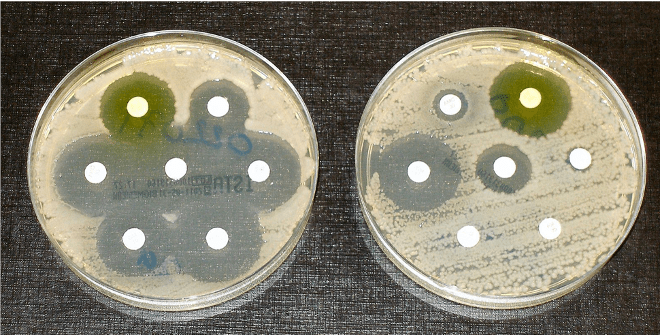Anahita Kodali, Life Sciences, News, Spring 2020
Figure 1: This simple experiment shows the effect of antibacterial resistance. In petri dishes, researchers put “lawns” of bacteria (the yellowish coating). The white dots have antibiotics. The left image displays bacteria that are not resistant to the antibiotics in the dots – the clear circles indicate that most of the bacteria close to the white dots were killed off. However, the right petri dish shows bacteria that were resistant to the antibiotics; the circles are much smaller or nonexistent for the most part, meaning that most of the bacteria were not killed.
Image Source: Wikimedia Commons
As the coronavirus pandemic has spread around the globe, it has also radically changed environmental conditions. Carbon emissions due to driving and manufacturing are plummeting 1, and there are several stories about endangered animals reappearing in urban settings2. However, environmentalists fear that these changes are only temporary, as governments will quickly employ stimulus programs in order to revive struggling economies; these stimulus programs incentive citizens to spend more money, ultimately resulting in more cars on the road and a return to the widescale industrial processing that caused the massive issues with air pollution in the first place3. More problematic in the short-term, however, is the rise in waste being created by the pandemic; several recycling programs have been suspended, and daily medical-waste volumes have skyrocketed. In fact, in Wuhan during the height of the pandemic, waste amounts went up 6-fold, and 29 cities were at full capacity4.
With the future of the environment uncertain, it is more important than ever to understand the current state of our world and the impact that pollution can have. Researchers from the University at Buffalo (UB) studied water pollution in Bangladesh, specifically searching for pharmaceutical chemicals in the water. The team took samples from a river, a lake, and a canal in the capital city of Dhaka, as well as several samples from ditches and wells in Matlab, a rural area of Bangladesh. After analyzing the samples, they found a mix of several different pharmaceutical compounds, including antibiotics, anesthetics, and antihypertensive drugs; additionally, they found flame retardants, insecticides and fungicides. While not all of the pharmaceuticals were found in every sample, the researchers did see the flame retardants, a powerful insect-repellent called DEET, and an antifungal called carbendazim at every site tested5.
These findings are critical and quite alarming. Of course, pharmaceutical chemicals can cause a great deal of damage to our already hurting environment. However, another issue is that antibiotic pollution in water can result in the creation of bacteria and fungi that are resistant to drugs (see Figure 1)6. It is not just antibiotics that could contribute to resistance, however. Dr. Aga, a chemistry professor in the UB College of Arts and Sciences, warned that recent studies have shown antidepressants could induce antibiotic-resistance in certain bacteria. This means that there is a possibility that several other chemicals could also cause resistance6. The world is already facing a major problem with antibiotic resistant bacteria; every year, almost three million people get an antibiotic-resistant infection, and about 35,000 die due to these diseases7. Antibiotic water pollution will only further exacerbate these issues. It is important to note that the findings in Bangladesh are not necessarily limited to just that country; researchers expect similar findings in any country that has poor management of antimicrobials6.
Hopefully, governments around the world will take careful consideration of these findings and others when passing regulations about the disposal of chemicals. With the current global pandemic, it is more important than ever to take steps to preserve our environment; treating our water better helps protect both the environment and our health.
Bibliography
[1] Storrow, B. (2020, April 6). 5 Ways the Economic Upheaval of Coronavirus May Impact CO 2 Emissions. Scientific American. Retrieved from https://www.scientificamerican.com/article/5-ways-the-economic-upheaval-of-coronavirus-may-impact-co2-emissions/
[2] McCoy, T. (2020, April 15). As humans stay indoors, wild animals take back what was once theirs. The Washington Post. Retrieved from https://www.washingtonpost.com/world/the_americas/coronavirus-wild-animals-wales-goats-barcelona-boars-brazil-turtles/2020/04/14/30057b2c-7a71-11ea-b6ff-597f170df8f8_story.html
[3] Denne, L. (2020, April 14). Coronavirus lockdowns have sent pollution plummeting. Environmentalists worry about what comes next. NBC News. Retrieved from https://www.nbcnews.com/science/environment/coronavirus-lockdowns-have-sent-pollution-plummeting-environmentalists-worry-about-what-n1178326
[4] Chaudhuri, S. (2020, March 30). Trash Industry Braces for Potential Deluge of Coronavirus Waste. Wall Street Journal. Retrieved from https://www.wsj.com/articles/trash-industry-braces-for-potential-deluge-of-coronavirus-waste-11585560600?ns=prod/accounts-wsj
[5] Luisa F. Angeles, Shamim Islam, Jared Aldstadt, Kazi Nazmus Saqeeb, Munirul Alam, Md Alfazal Khan, Fatema-Tuz Johura, Syed Imran Ahmed, Diana S. Aga. (2020). Retrospective suspect screening reveals previously ignored antibiotics, antifungal compounds, and metabolites in Bangladesh surface waters. Science of The Total Environment, 2020; 712: 136285 DOI: 10.1016/j.scitotenv.2019.136285
[6] University at Buffalo. (2020, April 20). Study describes cocktail of pharmaceuticals in waters in Bangladesh. ScienceDaily. Retrieved April 21, 2020 from www.sciencedaily.com/releases/2020/04/200420125436.htm
[7] Antibiotic / Antimicrobial Resistance. (2020, February 14). CDC. Retrieved from https://www.cdc.gov/drugresistance/index.html


Leave a Reply